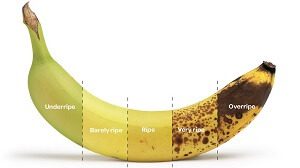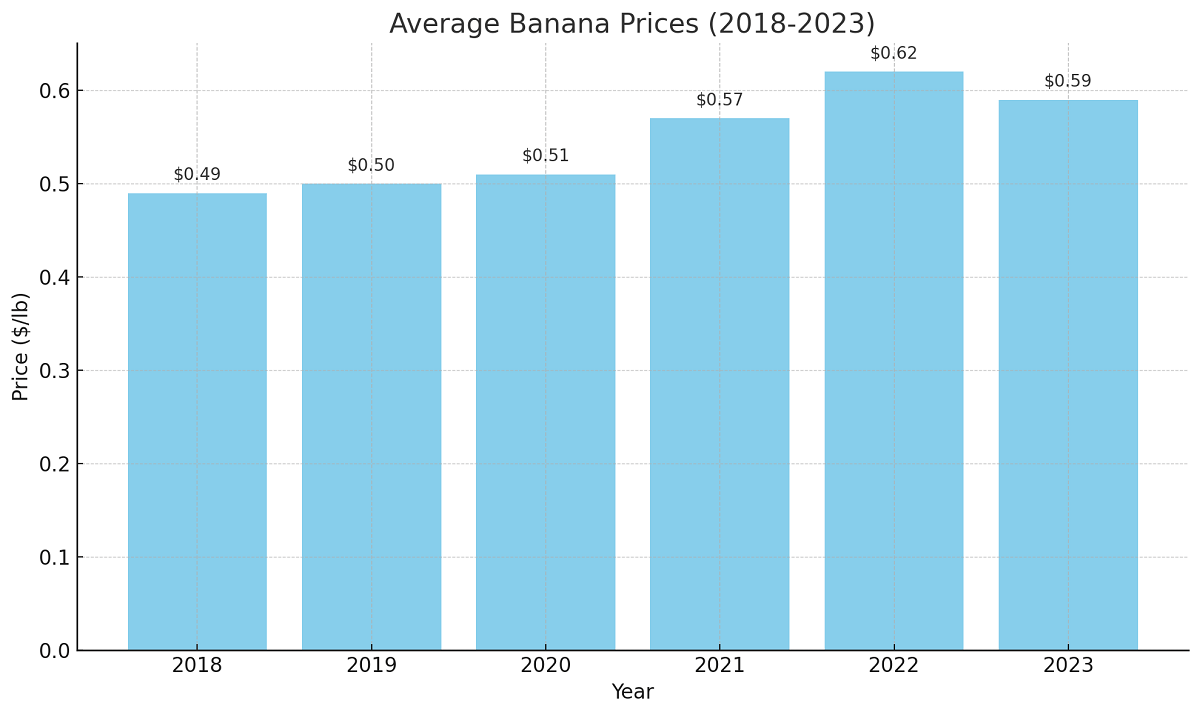How Much Does a Banana Cost?
Last Updated on September 19, 2023
Written by CPA Alec Pow | Content Reviewed by ![]() CFA Alexander Popinker
CFA Alexander Popinker
Bananas are among the most popular fruits in the world, being one of the top foods consumed worldwide and the most consumed fresh fruit in the United States.
The sweet yellow fruit is an important source of potassium, pectin, magnesium, vitamin C, and vitamin B6, as well as antioxidants, responsible for protecting the body against free radicals with which we come into contact daily.
How Much Do Bananas Cost?
One pound of bananas purchased from a local grocery store will be anywhere between $0.75 and $1.50, while the costs at a farmer’s market will be much lower. The price of a banana will depend on the time of the year or the place you buy it from.
For instance, the sellers at farmer’s markets from the Asian markets of San Francisco, California, are charging anywhere between $0.50 and $1 for one pound of bananas.
You can find pre-packed bananas at Costco, which come in bags of two or three pounds and are sold for $1.75 to $3.5.
The cost of a banana at Walmart ranges from $0.27 to $0.72, depending on the weight of the banana and the location of the store.
The price of exotic bananas such as purple bananas or red bananas is anywhere between $2.5 and $5 per pound.
Depending on the season, expect to pay anywhere between $1.50 and $5 per lb. for the organic bananas. For example, Walmart sells these organic fruits, which are priced at $2.02 per bunch of bananas.
What are the extra costs?
In general, the price of organic bananas is about 20% to 40% higher.
Bananas details
Bananas do not grow in trees as most people would think. Rather, they grow on a rooted structure that forms a stem above the ground. The plant is classified as a tree type, perennial. It is, in fact, the largest flowering herbaceous plant in the world.
Bananas are elongated, slightly curved fruits that grow in a banana tree, often grouped in large clusters. The peel variety is yellow, green, or red depending on the species, and pretty easy to peel. The inner part is a consistent amylaceous pulp with a sweet taste.
Most bananas grown worldwide are used for local consumption. In the tropics, bananas are a major source of food as well as a major source of income for small farmers. In the mountainous lands of East Africa, bananas are of the greatest importance as a staple food for the population.
India is at the top of the list by producing the largest number of bananas at around 30 million tons. It is followed by China with 12 million tons. In Southeast Asia, the Philippines ranks third with over 8 million tons of production.
Important things to consider
Some fruits and vegetables have a cheap price and have also multiple benefits for our health. Banana is one of the cheapest, and they can be considered the most economical fruit if we balance their price and their nutritional qualities.
 Bananas that are good for cooking have a dry texture, contain more starch, and can be used in soups, purees, or desserts, but are delicious when cooked or fried.
Bananas that are good for cooking have a dry texture, contain more starch, and can be used in soups, purees, or desserts, but are delicious when cooked or fried.
Those that are too ripe, with brown spots, contain more sugar than bananas with a still green tip, the latter being considered to be healthier.
If eaten together with a source of protein (nuts, seeds, whole grains), bananas help to normalize insulin secretion as a result of their high sugar.
You might also like our articles about the cost of apples, strawberries, or pineapples.
Bananas are the only fruits that contain amino acids, tryptophan, and vitamin B6 that help the human body produce serotonin, a natural chemical that relieves mental depression.
A study published in 2010 in the Biological Chemistry journal showed that a protein found in bananas would have the ability to prevent the reproduction of HIV-infected cells.
If you go to the gym, two bananas can provide enough energy for a 90-minute workout.
Even banana peels have beneficial effects on health. They can be applied to the skin to dry the pimples naturally. The banana skin can also be used as a natural fertilizer, having a positive effect on roses.
What do bananas contain?
Nutritional values:
- Vitamin B6 – 0.5 mg
- Manganese – 0.3 mg
- Vitamin C – 9 mg
- Potassium – 450 mg
- Dietary fiber – 3g
- Protein – 1 g
- Magnesium – 34 mg
- Folic acid – 25.0 mcg
- Riboflavin – 0.1 mg
- Niacin – 0.8 mg
- Vitamin A – 81 IU
- Iron – 0.3 mg
The recommended intake of potassium for adults is 4,700 milligrams per day.
How to store banana fruits?
It is important to note that bananas should not be stored in the refrigerator. Even the greenest one will suffer from the cold. Their aging process will be interrupted which will reduce their quality. They are exotic fruits and they do not go along with low temperatures. Therefore, the best way to store them is at room temperature.
You can put bananas next to other green fruits to slow down the ripening process. They will ripen harder and the other fruit faster.
Bananas oxidize quickly and therefore the recipes that contain these fruits should not be made long before they are eaten.
What does a ripe banana look like?
Average cost of bananas in the United States over the last 5 years
The current national average price for bananas in the United States is $0.63 to $0.64 per pound, as reported by the U.S. Bureau of Labor Statistics.
Based on typical banana market conditions, here are some rough estimates on average retail banana prices each year from 2018-2023:
| Year | Average Price of Bananas per Pound (USD) |
|---|---|
| 2018 | $0.49 |
| 2019 | $0.50 |
| 2020 | $0.51 |
| 2021 | $0.57 |
| 2022 | $0.62 |
| 2023 | $0.59 |
Here’s a chart to better illustrate the change in prices:

How will inflation affect the price of bananas in 2023?
Inflation is a key factor influencing banana pricing in 2023, though other variables will also play a role:
- The food inflation rate in the United States has increased by 4.3% in the 12 months ended August 2018 and by 6.7% in the 12 months ended May 2023. The cost of bananas has remained relatively stable over the last decade, with the retail price in the United States hovering around 58 cents to 64 cents per pound.
- Currency fluctuations will impact export prices, as banana exports are priced in dollars. A strong USD makes bananas more expensive for international buyers, potentially pressuring US retail prices down.
- As an imported product, bananas are impacted by fuel price fluctuations. Higher shipping expenses get passed through to retail pricing.
- Labor availability and wages in producing countries will affect farming and transportation expenses.
- Demand drops during economic downturns could potentially offset some input cost inflation.
- Like many goods, pricier packaging, fertilizers, and pesticides driven by inflation affect banana costs.
- Rising inflation from 2020-2022 increased costs for retailers and consumers. Banana prices at stores rose faster than global supply costs.
Experts state that US retail banana prices will remain elevated due to persistent inflation, but likely not increase dramatically above 2022 peaks.
How can I save money?
If you want to save money on the bananas try buying them from a local farmer’s market because, in most cases, the prices there will be lower and profitable compared with what you can find at a large grocery store.

Leave a Reply
Want to join the discussion?Feel free to contribute!